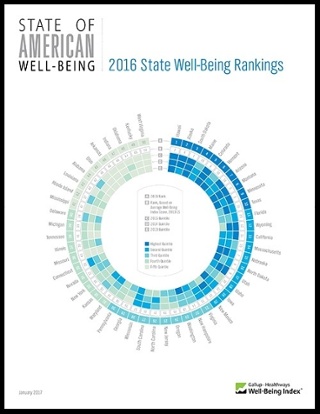Payroll
Ranking the Top States for Well Being
The research examines the five key elements of well-being – purpose, social, financial, community and physical – as well as other important health metrics within the United States. Through a daily survey of 500 adult Americans, the Well-Being Index ...
Feb. 15, 2017

Americans living in Hawaii, Alaska and South Dakota had the highest well-being in 2016, according to new research from Gallup and Healthways, a Sharecare company. In addition to leading the nation in the financial, community and physical elements of well-being, Hawaii’s Well-Being Index score of 65.2 is the highest score of any state in the last three years. Alaska and Texas led the nation in social and purpose well-being, respectively.
The research examines the five key elements of well-being – purpose, social, financial, community and physical – as well as other important health metrics within the United States. Through a daily survey of 500 adult Americans, the Well-Being Index creates a composite picture of health and well-being within each state that can inform public and private efforts to design and implement initiatives to improve well-being.
And while lesser-populated states tended to top the list, other mid-sized and small states also ranked as the lowest for well-being.
Highest Well-Being States
- Hawaii
- Alaska
- South Dakota
- Maine
- COlorado
- Vermont
- Arizona
- Montana
- Minnesota
- Texas
Lowest Well-Being States
- Mississippi
- Rhode Island
- Louisiana
- Alabama
- Ohio
- Arkansas
- Indiana
- Oklahoma
- Kentucky
- West Virginia
Residents of West Virginia, Kentucky, Oklahoma and Indiana reported the lowest levels of well-being in 2016, with each state having a Well-Being Index score of 60.5 or below. West Virginia placed last in the nation for purpose, financial and physical well-being, while Rhode Island had the lowest social and community well-being.
There are several positive well-being trends at the national level. Overall well-being in 2016 showed statistically significant gains in the Gallup-Healthways Well-Being Index since 2014. Additionally, in 2016 the nation had historically low smoking rates (at 18.0%, down from 21.1% in 2008); historically high exercise rates as measured by those who report they exercise for 30 minutes or more during three or more days in the last week; and the highest scores recorded on healthcare access measures, including the greatest number of Americans covered by health insurance and visiting the dentist. Americans also report the lowest rates of healthcare insecurity since 2008, as measured by not being able to afford necessary healthcare services once in the last 12 months.
All national well-being trends are not positive, however; the prevalence of chronic diseases such as obesity (28.4%), diabetes (11.6%) and depression (17.8%) are now at their highest points since 2008. The percentage of Americans who report eating healthy all day during the previous day is also at a nine-year low.
In the United States, higher well-being has been shown to correlate with lower healthcare costs and increased worker productivity, in turn enhancing organizational and community competitiveness. “Understanding and improving well-being should be foundational to the people strategy of any organization or community,” said Michael Thompson, President and CEO of the National Alliance of Healthcare Purchaser Coalitions. “Leaders have shown that well-being is essential to an engaged and thriving population and a key building block to success and sustainability. It can be a force multiplier by directly influencing healthcare costs, resilience, and innovation.”
“Well-being is a concept that goes far beyond physical health. It includes purpose, social, financial, and community factors, as well as physical vitality,” said Karissa Price, President at Healthways. “For employers, health plans, health systems and community leaders, this holistic view provides significant value. It’s a framework for understanding the root causes of poor health and it informs more effective strategies to encourage the sustained lifestyle changes that allow people to perform to their highest potential.”
The full report is available online.
